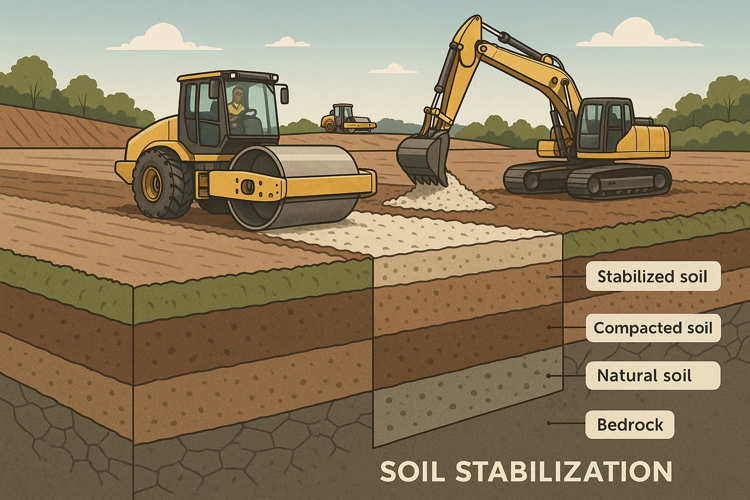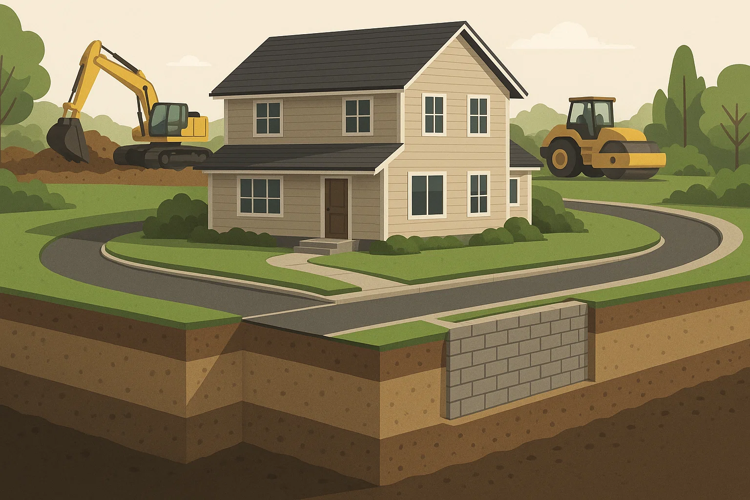
Home construction or land development is a thrilling experience. You may waste endless days and days, deciding on the kind of architecture, the type of interiors, and the kind of landscaping. But what of the ground on which you base your project on? The stability of the soil under any construction, whether a bespoke house or a massive shopping mall, is what determines the success and the lifespan of the construction. This is the place when one of the most important, however, frequently neglected processes is involved: soil stabilization.
It is important to know what soil stabilization is so as to appreciate the importance of this process in developing safe, durable, and appreciated properties. In simple terms it is the process of enhancing the physical characteristics of soil to make it stronger, more durable as well as less prone to erosion or shifting. You can call it a future on a sound basis. At any rate, it is possible without affecting the issues of cracking foundations, imperfect floors, and structural damages in the future.
Why Soil Needs a Helping Hand
Soil is a complicated combination of minerals, organic substances, water and air. It is extremely shiftless in its make up, though it can vary wildly in any given place, and even within an individual property. There are soils that have a natural strong base, such as dense clays or well-graded gravels. These other ones are not as compliant.
High clay soils are able to swell when they are wet and to shrink when dry and due to this movement, the ground can move. Sandy soils are loosely formed soils and they are not firm enough to hold a heavy structure. Such frail or faulty soils are able to undermine the integrity of whatever was constructed on them. This is where professional civil engineering services become indispensable. Specialists of the given sphere can study the soil structure on a location and conclude upon the most effective practices to enhance the load-bearing of soil and its longevity.
The Processes under a Stable Foundation
There are a number of methods available to engineers when it comes to soil stabilization and the method applied will depend upon the type of soil and the project. These techniques are classified into two broad categories; mechanical and chemical.
Mechanical Stabilization
This entails the enhancement of soil properties through altering the physical characteristics of soil. It is like rolling a dough to have the correct consistency. Techniques include:
Compaction: It is the most widely used, which implies that heavy rollers or vibrators are used to compress the soil particles. This will cause the air to be compressed and the soil becomes very dense and much stronger.
Mixing Soils: Sometimes, it can be as easy as mixing up the soils of different types. As an example, addition of sandy soil with a soil that is rich in clay can result in a more balanced and stable composite material.
Chemical Stabilization
In this process, the additives are incorporated into soil so that they cause chemical reactions between them to attach the particles together. It is a more developed solution in case of especially difficult ground conditions. Common additives include:
Lime: Lime is used to treat clay soil types and decreases plasticity and swelling capacity which makes the soil more workable and stable.
Cement: Cement is used to make soil hard and durable resembling weak concrete. It is an admirable type of road and foundation construction.
Fly Ash: Fly ash is a by-product of coal burning and can be mixed with lime or cement to form a powerful cement like material that enhances the strength of soil.
The Significance of Land Development
The foundation of the property is a must to any property owner/developer. Effective soil stabilization is a critical component of successful land devlepment services. It makes sure that all the roads and driveways, building foundations and retaining walls will withstand the passage of time.
There are several advantages of investing in proper soil stabilization at the first instance:

Improved Safety and Durability: It establishes a strong base that avoids structural breakdowns that will safeguard the investment and the individuals who will utilize the real estate.
Cost Savings: It is much cheaper to deal with soil concerns prior to construction as opposed to fixing a cracked foundation or a sunken driveway in the future. It avoids expensive maintenance issues that may occur in the long term.
Higher Property Value: A decent house on a secure land is an asset. It gives future customers confidence and presents quality workmanship.
Sustainability: On-site soil utilization and its enhancement minimizes the necessity of transporting the bad soil off-site and bringing in new one, which minimizes the carbon footprint of the project and can lead to cost reduction.
The construction of a Confidence Foundation
Though it is not the most glamorous aspect of a construction project, it is certainly one of the most important. It is the invisible superman that makes your beautiful house or magnificent project safe, sound, and secure till generations to come. Once you have appreciated its importance, you will be in a better position to make better decisions and have a foundation, which you can trust on whether to build your project on.





(0) comments
We welcome your comments
Log In
Post a comment as Guest
Keep it Clean. Please avoid obscene, vulgar, lewd, racist or sexually-oriented language.
PLEASE TURN OFF YOUR CAPS LOCK.
Don't Threaten. Threats of harming another person will not be tolerated.
Be Truthful. Don't knowingly lie about anyone or anything.
Be Nice. No racism, sexism or any sort of -ism that is degrading to another person.
Be Proactive. Use the 'Report' link on each comment to let us know of abusive posts.
Share with Us. We'd love to hear eyewitness accounts, the history behind an article.